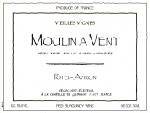Potel-Aviron, Moulin à Vent (Beaujolais, France) 2005 (Wildman, $20): I was blind-tasting a group of Beaujolais wines,  many of them cru Beaujolais, when I came upon this wine. It seemed completely out of place because it was so much more concentrated than the other wines. For my immediate purpose of identifying 'summer wines' to recommend to mainstream wine drinkers, it was useless. But as a fine wine to recommend to wine lovers…bingo!
many of them cru Beaujolais, when I came upon this wine. It seemed completely out of place because it was so much more concentrated than the other wines. For my immediate purpose of identifying 'summer wines' to recommend to mainstream wine drinkers, it was useless. But as a fine wine to recommend to wine lovers…bingo!
Potel-Aviron is a collaboration between Nicolas Potel--son of Gerard Potel, who is well-known to Burgundy aficionados as the former owner of Domaine de la Pousse d'Or in Volnay--and Stephane Aviron, whose family has long been involved in winemaking in the Beaujolais district. They partner with small winemakers to select grapes and make wines under the Potel-Aviron label. Potel also acts as a negociant in Burgundy.
This particular wine comes from four vineyard plots, including the superior Rochegres, considered one of the finest terroirs of Moulin à Vent, and from vines that are 50 to 60 years old. Vinification involves traditional Beaujolais techniques: whole bunches, no added yeast, and fermentation in cement tanks for 11 to 15 days, according to Aviron. The Moulin à Vent then ages for a year in barriques, of which 40% are new, 20% are two years old, and 40% are four to six years old.
What first impressed me about this wine, in the context of Beaujolais, is its sleekness. It carries itself like a fine wine--a sophisticated wine--more than a country wine. I suppose by that I mean that it is smooth despite having significant tannin and that it has depth and refinement within a substantial whole. More specifically, this is a dry, fairly full-bodied wine with a moderate amount of firm tannin that runs all through the wine's texture, from forepalate to rear. Flavors of black berry fruit are well-knit, concentrated and tight, and aren't as expressive now as they will be in time. Compared to other Beaujolais crus, this has a freshness and focus of fruit character due to its oak aging--but it has no flavor of oak per se.
I am excited when I find Beaujolais wines of this caliber because they represent the highest potential of a classic wine region and a great grape variety. Beaujolais deserves wines like this, and the Gamay grape deserves to have as its emissary such seriously good wine.
I prefer to drink this wine from a medium-sized Bordeaux glass rather than from a round-bowled Burgundy glass because the leaner glass seems to concentrate the wine all the more and also bring out spicy notes. I would pair the wine with almost any meat dish or 'meaty' vegetable dish. It will stand up best to dishes that are not intensely flavorful.
Many boutique Beaujolais wines have small production and are hard to find. This is no exception, with only 500 cases coming into the U.S. But thanks to the national reach of its importer, Frederick Wildman and Sons, you have a shot of finding it in major markets across the country.
91 Points